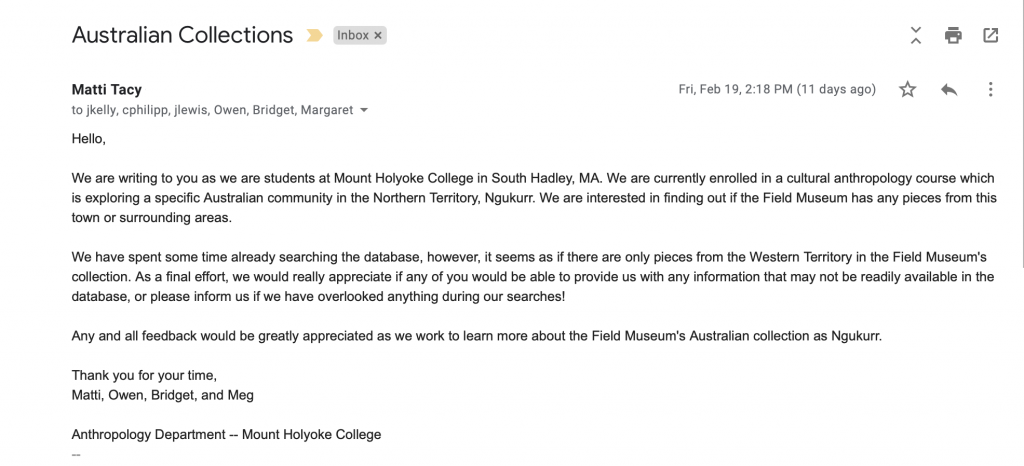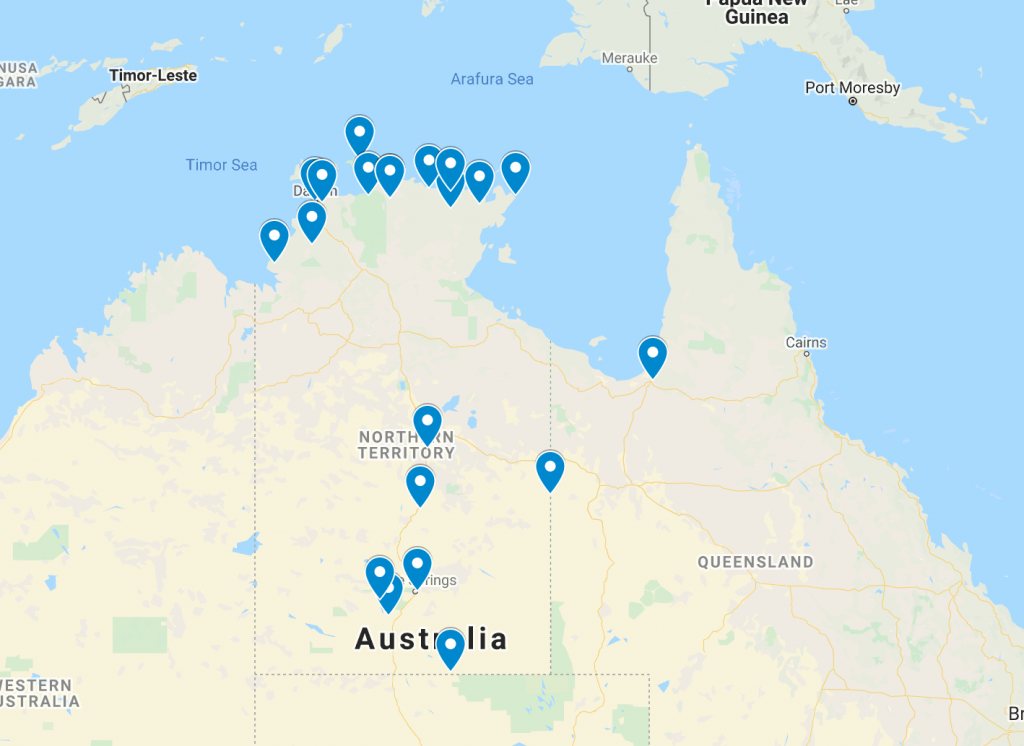Initial Search Terms
Upon finding the Field Museum’s anthropological database we began with simple search terms such as Australia, producing 1012 initial results; and Aboriginal, Indigenous, Aboriginal Australians, producing 439 initial results. These basic keywords produced limited information, as many pages described similar items, including wooden bowls, ceramic/clay vessels, clubs, spears, hammers, boomerangs, and seeds. Despite these results, no items were from the Northern Territory. Furthermore, in most cases, the database only had descriptions of the relevant cultural items and did not display any photos of the objects. This was challenging for research purposes as we were unable to view the cultural items from Australia. Lastly, it should be noted that nearly one-third of these results were donated by the University of Melbourne and a man J.F. Connelly, two pieces of information that was unable to be further searched in the Museum’s database, but may be a point of exploration for future research. This proves the lack of diversity in the collection.
Additionally, we searched more specific keywords such as Northern Territory, Australia (the specific region of the Ngukurr Community), producing 17 initial results; all but one were attributed to Papua New Guinea and were acquired by the same individual. These results lacked Aboriginal Australian works but did include audio files describing the objects’ known origin. Our initial search concluded with the very specific term Ngukurr (the location and group), which produced zero initial results.
We have chosen to omit images of results as no items were traceable to the Ngukurr community or area.
For more information on this database please visit the Field Museum’s site: https://collections-anthropology.fieldmuseum.org
Further Search Terms
After the general search terms yielded no results relevant to our research, we decided to search the database using more specific language to Ngukurr like descriptors of location, language, and names associated with items. For location based searches, we used the name of the colonizer mission created in the early 1900s on Ngukurr land, Roper River Mission and the geographical position of Ngukurr, (Southern) Arnhem Land. We also tried researching terms such as Pellew (Islands) and Timor (sea) as we thought those terms might help align our results to the Northern Australian region.
However, neither searching the locality nor any language based terms like Kriol, Ngalakan, or Alawa (which are examples of languages spoken in Ngukurr and surrounding Roper River regional languages) produced any search results. Even combining terms such as Kriol + Australia only yielded one result, an Australian piece which was based in the wrong region for our research, Western Australia. Thus, our final search was a name that we had seen repeatedly associated with items in the Australia based collection, J.F. Connelly, a “collector” for the museum. His name generated over 400 results, unfortunately all the results could be attributed to the western region.
Difficulties with Searching
Contacting the Field Museum
After two weeks of searching keywords related to the Ngukurr community– we had not yielded any concrete results related to Ngukurr or the Northern Territory. At this point we located the contact information of the Head of Anthropology Collections, Jamie Kelly, the Collections Manager, Chris Philipp, and another Collections Manager, Jamie Lewis. We emailed these three individuals to inquire about any objects in the Field Museum’s collections related to Ngukurr. Reaching out directly to the individuals who work with the collections can be very effective and efficient for this specific research.

Correspondence with Field Museum Worker: Christopher Philipp
Collections Manager Christopher J. Philipp responded to our initial email two days later and provided us with information about the Field Museum’s Pacific Islands Collection. We will not be showing his exact response, as we have not obtained permission to do so.
In his response, we learned that the Field Museum’s database is currently offline and that there are around 240 items in the collection from Australia’s Northern Territory. Because the museum recognizes that their online database is not complete, they are currently working to publish more and more online. Besides just listing each object, they are also working towards having more records, documents, and photos available. For objects from the Northern Territory, we were given the timeline that this could be completed in the next couple of months, but it would not show up until the database is back online, for which there is no expected date.
He then pointed us to filling out an information request form, so that we could receive a listing of the material from the Northern Territory. Within a week after filling out the form, we received another email from Christopher Philipp. In this email, he summarized the results of searching within the Northern Territory. There were no results from Ngukurr, Roper River Mission, and other related names and places.
Attached to the email was a spreadsheet of the Northern Territory records of objects that are not labeled as sacred, totalling 232 items. This spreadsheet, like the Field Museum’s online database, was difficult and confusing to read. For each item in the collection, there were 22 categories of information about the object, including “description”, “site”, “ethnic group”, “providence”, and others. The spreadsheet contained no photos or records, and only short, often one-word descriptions of the items, which made it difficult to understand what exactly each item was. In addition, many of the objects were labeled as originating from the ethnic group “aborigine”, even when an origin location was named.

Conclusion
Regenstein Collections Manager, Christopher J. Philipp, expressed that there is an ongoing effort to get the 232 unlisted objects from the Northern Territory into the Field Museum’s database. The original goal was to have this completed by the end of February 2021. As of March 3, 2021 however, these objects are not on the database and are only available through an excel spreadsheet described earlier or by physically visiting the museum. While difficult to navigate in its own ways, the database is more accessible than the spreadsheet and would provide more information. Specifically, Phillip indicated that the museum plans on adding images of Northern Territory objects, which will be essential in the identification of which groups the objects belong to. There is no definitive date for when the listings will be available on their database, but hopefully these items are added in the near future. It is something to revisit periodically.
The fact that over 200 objects are in the Field Museum’s possession without full/accessible access to information about those items is concerning. It creates a further barrier between the Field Museum and communities (such as Ngukurr), whose items may be in the museum’s possession. In many instances, Indigenous people have requested the return of items that hold cultural significance. If this were a desire of the Ngukurr community however, it would not be achievable at this moment because the general public does not even have the knowledge of what items are in the Field Museum’s possession. Additionally, descendants of the original owners of certain items may want to learn more about those items in order to connect with their ancestors. Connecting to one’s own Indigenous history can be a way of reclaiming power and sovereignty in a necropolitical system that has historically prevented Indigenous Australians from claiming their own culture (through acts of forced assimilation among other things). Not only are these objects in the possession of those halfway across the world, but they cannot even be properly researched or identified. As explained earlier, identifying an object as belonging to a specific group of people is made easier when one can view an image, and this is a key element that is missing as the items are not photographed and in the online database.
–
What does it mean that a high school student in Chicago could walk into the Field Museum and view items belonging to Aboriginal communities, while those from the communities cannot even obtain the knowledge of whether their items are in the museum? In many ways it signals that museums are in need of decolonization. Museums like the Field Museum must prioritize ways of accessing information that is not dependent on physically being at the museum itself. Making a trip from the land now known as Australia to Chicago is not a reasonable expectation when attempting to view items that should have arguably never left Australia and Ngukurr land to begin with. Pathways for Indigenous people to relocate their items should be created by institutions such as the Field Museum.
We remain hopeful that in the near future some of these items will be available electronically– and we may even discover that select items will be from Ngukurr! We recommend that future researchers check back with the Field Museum’s collections once they are made public as these items are currently unknown.
Citations
Chicago, 2021. https://collections-anthropology.fieldmuseum.org.
Last updated March 5, 2021.
We’re not sure / not in a position to make a decision at this time regarding being involved in future use of this material. Please contact this individual as point-person for our group to further discuss, if/as applicable: Bridget Maloney, malon23b@mtholyoke.edu